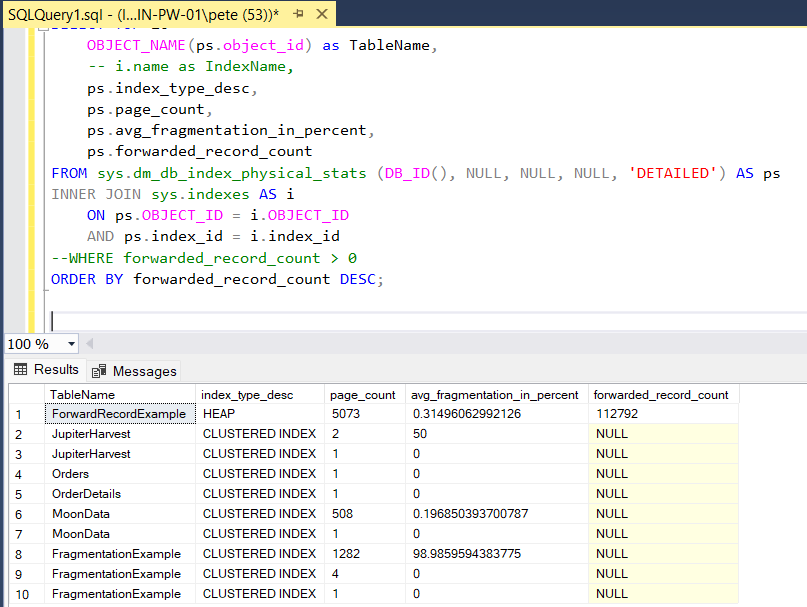SQL Server heap fragmentation can significantly impact database performance and efficiency. In this blog post, we’ll dive into the causes of heap fragmentation, its effects on SQL Server performance, and effective strategies to mitigate and manage it.
In SQL Server, a heap is a table without a clustered index, where data is stored in an unordered manner. Heap fragmentation occurs when data pages become disorganized or scattered, leading to performance degradation. Understanding the causes and consequences of heap fragmentation is crucial for maintaining a healthy and efficient database environment.
Heap Fragmentation in SQL Server
Causes of Heap Fragmentation
1. Inserts, Updates, and Deletes: Frequent data modifications can result in page splits and fragmentation within the heap.
2. Variable-Length Data: Tables containing variable-length columns may experience increased fragmentation due to page splits caused by data growth.
3. Data Movement: Reorganizing or rebuilding indexes, table truncation, or partition switching can also contribute to heap fragmentation.
4. Small Extents: Allocation of small extents for data storage can lead to increased fragmentation over time.
Impacts of Heap Fragmentation
1. Decreased Performance: Fragmented heaps require additional disk I/O operations to access and retrieve data, resulting in slower query execution times.
2. Increased Storage Requirements: Fragmentation leads to inefficient use of storage space, necessitating larger disk allocations to accommodate data.
3. Index Fragmentation: Heap fragmentation can also impact the performance of associated non-clustered indexes, exacerbating performance issues.
4. Extended Backup Times: Heap fragmentation can cause your backups to take longer to complete. If your backups are taking more than 12 hours to complete you may be looking to optimize.
Strategies to Manage Heap Fragmentation
1. Regular Maintenance: Implement routine maintenance tasks such as index reorganization or rebuilding to defragment heaps and optimize performance.
2. Clustered Indexes: Consider adding clustered indexes to heap tables to organize data and reduce fragmentation.
3. Fill Factor: Adjust the fill factor parameter to reserve space within data pages, minimizing fragmentation during data modifications.
4. Data Archiving and Purging: Remove unnecessary data and archive historical records to reduce heap fragmentation and improve database performance.
5. Monitoring: Utilize SQL Server performance monitoring tools to track fragmentation levels and identify tables prone to fragmentation.
Advantages of Using Heaps
Even in the context of heap fragmentation, there remain notable use cases for employing heaps in database design. In scenarios such as loading staging tables or storing protocol data, heaps offer advantages. Unlike clustered indexes, heaps don’t mandate meticulous sorting during data storage, making them particularly efficient for these tasks. Data records are seamlessly stored on available data pages without the need to navigate the index structure, streamlining the INSERT process.
SQL Script: Show Forward Record Counts
The SQL Script below returns all forward record counts for a database. As described above in this article, this can be used as an indication for heap fragmentation, if a really big number is returned, this is probably a good thing to be looking at. To show heaps in a SQL Server database we are querying the sys.indexes system table as shown in the SQL below:
-- Show Forward Record Counts in SQL
SELECT TOP 20
OBJECT_NAME(ps.object_id) as TableName,
-- i.name as IndexName,
ps.index_type_desc,
ps.page_count,
ps.avg_fragmentation_in_percent,
ps.forwarded_record_count
FROM sys.dm_db_index_physical_stats (DB_ID(), NULL, NULL, NULL, 'DETAILED') AS ps
INNER JOIN sys.indexes AS i
ON ps.OBJECT_ID = i.OBJECT_ID
AND ps.index_id = i.index_id
--WHERE forwarded_record_count > 0
ORDER BY forwarded_record_count DESC;

The above example does not show a big concern with numbers, and it’s a very small database.
